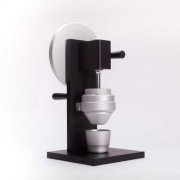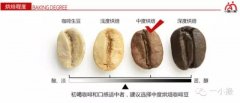Bakers must know baking knowledge.
Equilibrium point
When the roaster is fully preheated and the internal temperature of the boiler is about 200 degrees, put the prepared raw beans into the furnace. At this time, the raw bean in the furnace begins to endothermic reaction, and the internal tissue of the raw bean begins to endothermic reaction, that is, the sound bean begins to absorb heat, absorbing all the temperature in the furnace into its own body, so the temperature in the furnace begins to drop slowly, and when the temperature inside the furnace is gradually consistent with the temperature in the raw bean, it is called the equilibrium point.
At this time, it is one of the important links in the taste and aroma of coffee. If the balance is wavering, the flavor of coffee will become confused. Because the type of coffee roaster is different, the time of the balance point will be deviated, so the roaster should master the balance point of the roaster he uses. That is, the equilibrium point time corresponding to the amount of raw beans, the equilibrium point time corresponding to different seasons, the equilibrium point time of heat sources such as liquefied gas gas (LPG) or natural gas gas (LNG), the horizontal length of the inner and outer chimneys connected with the bean dryer, or the vertical height are all different, which should be carefully observed.
Temperature recovery point
After the equilibrium point, the furnace will remain unchanged for a few seconds or minutes. Then the temperature will warm up, and this point in time becomes the temperature recovery point. Although the recovery point of different models is different, the equilibrium point and temperature point of most semi-hot air and direct fire roasters are almost the same, that is, the temperature begins to rise slowly.
Generally speaking, there is about 30 seconds between the on-board equilibrium point and the return temperature point of the direct baking machine-one minute, and the temperature does not change. The semi-hot air will be converted to the temperature recovery point immediately after the equilibrium point.
After passing the temperature recovery point, the moisture of raw beans begins to evaporate, so it gives off a fishy smell, which varies according to the moisture content of raw beans and the size of firepower supply.
Light yellow spot
After the temperature recovery point, the temperature in the furnace began to rise slowly. In the case of high temperature baking, the light yellow spot is characterized by direct baking arriving in about 4 minutes, while semi-hot air or hot air appears in 6 minutes. The light yellow dot is also the time when raw beans change from raw bean flavor to sweet taste. the sweetness felt in the light yellow spot varies with the processing method of raw beans, and the sweetness of sun-cured raw beans is more obvious. In addition, the time of sweetness will vary depending on the water content of raw beans, and raw beans with water paste will be slower than those with low water content.
Yellow spot
When it comes to the yellow spot, the wrinkles on the surface of raw beans will gradually appear, which is a phenomenon caused by the evaporation of water in raw beans. In the endothermic reaction, the yellow dot is the time point at which water evaporates most. The density of raw beans also has an effect on the amount of wrinkles. For example, if raw beans with the same moisture content but different densities are baked at the same time, the raw beans with high density will produce more wrinkles than those with low density.
For example, the Brazilian bean of the new world bean variety has a moisture content of 10%, and there are fewer wrinkles on the surface of the original bean at the time of the yellow dot, while in the Kaddura species of Colombia, if the moisture content is 10%, the wrinkle of the original bean noodle will look deeper.
An explosion
At the end of the endothermic reaction stage and the first burst, the heat protection reaction is carried out immediately.
The sound produced by the expansion effect produced by the preheating of raw beans during the first burst, the sound and time of bursting will vary with the variety, density and vitality of the endothermic reaction stage. Under the condition of high temperature baking, direct fire baking will occur in 7 minutes, while semi-hot air or full hot air will occur in about 9 minutes.
An explosion represents the official beginning of the chemical reaction of raw beans. Generally speaking, we take continuous bursting as the starting point. Before that, there will be a single burst sound (when the tissue of raw beans changes, some raw beans will burst). Under this condition, please do not take a single burst sound as the basis. After a single burst sound, the continuous burst sound will begin soon, and this point in time can easily be used as the basis for the confirmation of an explosion.
After the explosion starts, you will smell a sour smell. With the passage of time, the sound of bursting becomes louder and louder, and you can feel that the sour taste is getting stronger and stronger, and the strength of this sour taste will vary from place to place. For example, raw beans at high altitude taste more sour than those at low altitude, and sun beans taste more sour than washed beans.
When the sour taste irritates to the depths of the nasal cavity, please reduce the firepower. If the firepower is not reduced and continues, the temperature will show a black curve and continue to rise; while after the nasal cavity is stimulated by sour taste, confirm and adjust the firepower, the temperature rise in the furnace will gradually slow down and show a blue curve.
The second explosion (the fire is not reduced in the first explosion)
As I just said, if the firepower is not adjusted when the explosion is dense, the temperature in the furnace will rise. If you use fresh raw beans with a water content of more than 10% for baking, the finished product with less firepower during the second explosion will have a brighter reddish brown than the original bean without firepower adjustment; if you use a direct-fire baking machine, you may have to adjust the firepower up at the same time or just before the second explosion. Because if the direct fire is not hot enough, it will cause the second explosion later, or the overall baking time will be prolonged. This situation has a bad effect on the taste and flavor of coffee, causing strong bitterness and its bitterness will stay in the mouth for a long time, resulting in a large loss of aroma.
The second explosion (reducing fire when the first explosion occurs)
After an explosion, the blue curve after firepower adjustment is reduced. The blue curve is relatively flat, on the whole, there is no downward trend, but shows a slowly upward trend. In case of a downward trend, it means that if the firepower is too strong, the beans baked in this case are darker, called dark black, bitter and aftertaste, and will become insipid and tasteless coffee.

Important Notice :
前街咖啡 FrontStreet Coffee has moved to new addredd:
FrontStreet Coffee Address: 315,Donghua East Road,GuangZhou
Tel:020 38364473
- Prev

Use chemical knowledge to help you analyze the coffee ingredients of individual coffee products.
Any coffee enthusiast who knows how to drink coffee knows that really high-quality coffee is not too bitter, but for most of us, most of the coffee we drink is bitter. Fortunately, through the principles of chemistry, even laymen without professional training can make coffee of good quality! It's like adding salt to coffee to lighten the bitterness, science can
- Next

Roaster Skills Coffee Knowledge Roasting Coffee Beans
More than a decade ago, the technology of coffee roasting was often secret. Since the employees of roasting factories usually became competitors independently, it was common for inheritance between father and son or relatives. In addition, the purchase cost of large machines was quite expensive, and the threshold for roasting coffee by themselves was too high, making coffee roasting a monopoly of a few large factories.
Related
- Beginners will see the "Coffee pull flower" guide!
- What is the difference between ice blog purified milk and ordinary milk coffee?
- Why is the Philippines the largest producer of crops in Liberia?
- For coffee extraction, should the fine powder be retained?
- How does extracted espresso fill pressed powder? How much strength does it take to press the powder?
- How to make jasmine cold extract coffee? Is the jasmine + latte good?
- Will this little toy really make the coffee taste better? How does Lily Drip affect coffee extraction?
- Will the action of slapping the filter cup also affect coffee extraction?
- What's the difference between powder-to-water ratio and powder-to-liquid ratio?
- What is the Ethiopian local species? What does it have to do with Heirloom native species?

